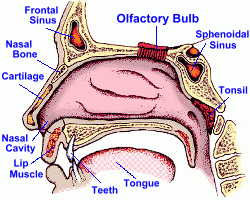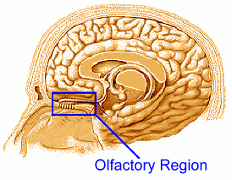 Your nose helps you to breathe, and it allows you to smell. We'll look at each of these functions and explain in detail how they work.  The outer portion of the nose is the part you can see. It is made from cartilage, a soft rubbery tissue that gives it its shape; it's attached to your skull at the nasal bone. Inside, the nose is divided into two cavities, leading from each nostril, which are separated by another strip of cartilage called the septum. In the diagram at the right, you can see one of these cavities, leading into the head. The inner nasal cavity is also connected to other cavities called sinuses. The outer portion of the nose is the part you can see. It is made from cartilage, a soft rubbery tissue that gives it its shape; it's attached to your skull at the nasal bone. Inside, the nose is divided into two cavities, leading from each nostril, which are separated by another strip of cartilage called the septum. In the diagram at the right, you can see one of these cavities, leading into the head. The inner nasal cavity is also connected to other cavities called sinuses.The nostrils are lined with stiff hairs that keep dust, dirt, microorganisms, and even small insects from being breathed into your lungs. The larger inner nasal cavity is very deep, and connects to your airway, and to your inner ear via the eustachian tubes. There are mucous membranes within the nose, which secrete a thick mucous that also helps trap dirt. At the top of the inner cavity is the olfactory bulb, which contains the receptors that collect molecules and help you smell. There are actually four sinus cavities, each with a left and right half: - Frontal Sinuses - above your eyes, just behind the forehead. - Maxillary Sinus - to the side of the nose, and below the eye, just above the upper teeth. - Ethmoid Sinus - between the eyes. - Sphenoid Sinus - far back in the head, behind the eyes, above the throat. The mucous in your nasal cavity also helps to warm and moisten the air you breathe in, to help prevent damage to your lung tissue. Rhinitis is an inflammation of the mucous membrane of the nose. The symptoms of rhinitis are a watery discharge from the nose often associated with congestion, and difficulty in breathing through the nose. Rhinitis is usually caused by the common cold, allergies, or irritation from breathing pollutants. Treatment includes decongestant medication to shrink and dry the swollen mucous membranes. Antihistamines are used to treat rhinitis caused by allergies.  Smell Smell In order for you to smell something, molecules from the thing you're smelling have to enter your nose. Everything you smell, therefore, is giving off molecules. Those molecules are usually small, easy to evaporate chemicals that float through the air into your nose. A piece of metal has no smell because nothing evaporates from it. These molecules floating into your nose are called odorants. They stimulate sensory nerve cells (neurons) in the olfactory bulb called receptors, which send electrical impulses to the brain.  The olfactory bulb contains other receptors called trigeminal nerve receptors. The trigeminal nerve (which is the largest cranial nerve, connecting the face, teeth, and mouth to the brain) provides a second set of nerve endings which are responsible for touch, pressure, pain and temperature sensations in the mouth, eyes and nasal cavity. Certain chemicals produce effects described as hot, cold, tingling or irritating when detected by the trigeminal nerve. For example, menthol produces the feeling of cold (or hot, in high concentrations); the chemicals capsiacin in hot chili peppers and diallyl sulfide in onions also stimulate this nerve. Human beings have a very weak sense of smell, and it doesn't always work well. When we have a cold, excess mucous blocks the receptor cells, and we have trouble smelling. When we smell the same odour for too long, the receptor cells get 'tired', and stop sending signals to the brain, so we stop smelling the persistent odour.  However, humans can discriminate between thousands of different odorant molecules, each with its own structure. As mammals, our DNA contains about a thousand genes that code for different odor receptors. However, humans can discriminate between thousands of different odorant molecules, each with its own structure. As mammals, our DNA contains about a thousand genes that code for different odor receptors.Dogs can distinguish between the smell of T-shirts worn by non-identical twins (they can't tell the difference between identical twins). Children can distinguish between the smell of their brothers and sisters and other children of the same age. Babies recognise their own mothers' smell, and mothers recognise their own babies' smell. Emotion can be communicated by smell as well; dogs and horses can apparently smell 'fear' in humans. The emotions of others, for example fear, happiness, contentment, or sexuality, may be communicated between people by smell. Memory is often associated with smell. Smell and memory are closely linked, although we aren't sure exactly how the process works. Smell can evoke memories, and our memory of odours seems to last longer than other memories. Like sound, odour is a memory cue. When the brain learns something that is associated with a smell, coming into contact with that same smell at a later date will bring back complete memories of everything the brain learned that was associated with that smell, including any associated emotions. This is called the "Proust effect". Many studies have shown that remembering can be enhanced if the learning was done in the presence of an odour, and that same odour is presented at the time of recall. For example, you might study for a Social Studies test while smelling a pair of stinky socks; if you take the socks to the test, their smell will help you recall what you learned!

|
